Powerhouse workstation gives excellent, balanced, top-end performance.
By Alex Herrera
 Boxx may not be a Tier 1 workstation supplier by a measure of unit volume, but Boxx certainly qualifies as top-tier when it comes to the performance and quality of its workstation products. Boxx is a supplier of workstation-class products to professional markets. It’s developed a loyal following, first and foremost in digital media segments and secondarily (and more recently) in CAD markets. We’ve had the privilege of reviewing several Boxx machines over the years, including the liquid-cooled 3DBoxx 4150 Xtreme in January 2014.
Boxx may not be a Tier 1 workstation supplier by a measure of unit volume, but Boxx certainly qualifies as top-tier when it comes to the performance and quality of its workstation products. Boxx is a supplier of workstation-class products to professional markets. It’s developed a loyal following, first and foremost in digital media segments and secondarily (and more recently) in CAD markets. We’ve had the privilege of reviewing several Boxx machines over the years, including the liquid-cooled 3DBoxx 4150 Xtreme in January 2014.
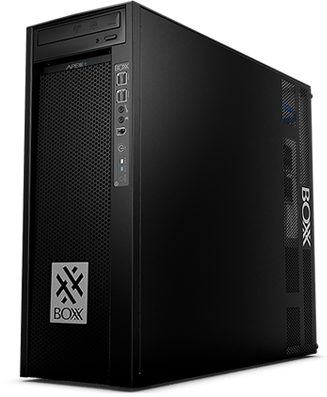
The company introduced a new, high-performance successor to the 3DBoxx, the Apexx series, and in April of 2015, we took a Performance Edition Apexx 4 (model 7402) into the Jon Peddie Research Mt. Tiburon Testing Lab to learn what improvements the company has designed into its premier line during the past year. With upgrades in several areas, our test unit Apexx 4 priced out at $7,457, making it a high-end desk-side machine by JPR metrics. It’s middle of the road (intentionally) in size and capacity, but with its top-end single-socket CPU and GPU, along with high-performance memory and storage, it was designed to deliver the ultimate in performance for its category.
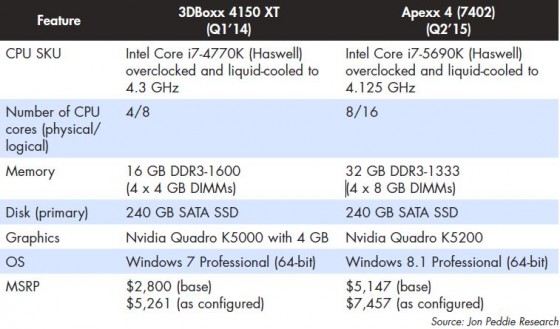
Good stuff right out of the box
Sometimes the little touches matter most. And we noticed the first little touch within seconds of opening the Apexx 4’s box. In one of the packaging compartments, we found a stash of virtually every cable—display, power, SATA—and adapter that a buyer might ever need when hooking up their new Apex workstation.
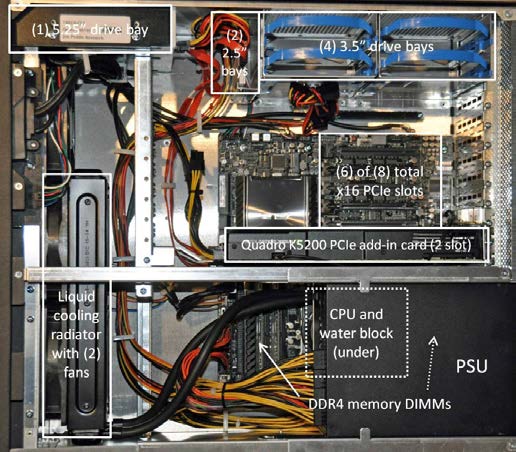
Sound trivial? Maybe, and maybe not. Consider what happens when you open up your new workstation and you’re anxious to get to work and under the gun. You go to connect your monitor and realize your monitor only supports VGA and DVI inputs while your fancy new graphics card only supports DisplayPort. But with this little care package of cables and adapters, Boxx has you covered. You’re up and running quickly, without having to burn half your day running to Best Buy for an adapter or having something sent overnight from Amazon or New Egg. When considering what a half day of your time is worth, maybe it’s not such a trivial touch.
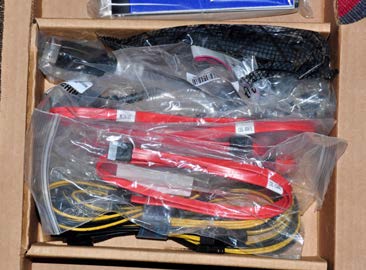
The basics of Apexx 4’s build (anything but basic)
Like the 4150 Xtreme, our Apexx 4 came with a liquid-cooled, overclocked Intel Haswell Core i7 processor. The CPUs were not identical, however. Whereas the 4150 XT’s quad-core Core i7-4770K was overclocked to 4.3 GHz, our octal-core Apexx 4’s Core i7 scaled up only to 4.0 GHz, but it did so with twice the number of cores.
No doubt the overclocked, liquid-cooled CPU is the Apexx 4’s centerpiece. However, it’s far from the only high-performance component available for this model, and ours came with its fair share of premium parts. For graphics, Boxx chose the ultra-high-end Nvidia Quadro K5200 GPU with 8 GB of graphics memory. And for main memory, our Apexx 4 had 32 GB—double last year’s 4150 XT’s footprint—of 2133 MHz DDR4 memory (DDR4 memory support introduced with Haswell-E launch in the fall of 2014). Backing up that memory is a 240 GB solid state drive (SSD) from Intel, essentially the same as in our previous 4150 XT.
Tool-less, shmool-less … that’s not Boxx’s game
After we explored plenty of machines from high-volume vendors HP, Dell, and Lenovo, the first thing we noticed about the Apexx 4’s chassis—as we did with its predecessor’s—is the absence of the popular ergonomic features its rivals have all adopted. Forget the carrying handle on top to ease transport, and don’t bother looking for the common tool-less finger trigger to release the side panel, either. Once inside, there are no color-coded, finger-activated release tabs to access add-in cards, storage bays, and power supplies.
But what Boxx lacks in tool-less design, it makes up for in robustness, with engineers prioritizing maximum physical integrity over quickest access. That means more metal and less plastic, more screws (the external ones are thumb-type), and fewer tabs. It’s the right choice for maximum robustness, and given the company’s positioning relative to its higher-volume, mainstream workstation rivals, it’s probably the right trade-off for Boxx.
However, with a bit more time and a Phillips screwdriver in hand, we can gain access in the Apexx 4 to everything we could with a rival’s tool-less design. While the drive bays and add-in cards slots are immediately accessible after removing the side panel, getting at the CPU and memory DIMMs requires removal of the power supply. It’s not a particularly difficult chore, but wasn’t nearly as easy or graceful as it was with one of the Apexx 5’s predecessors, the 4150XT. That chassis also required getting the power supply out of the way to access CPU and memory, but it did so with a cleaner swing-away mechanism. Removing the Apexx 5’s PSU was more difficult, but not ridiculous.
What did turn out to be a pain, however, was removing the Nvidia Quadro K5200. The double-width card sits right on top of the Asus X99-E motherboard’s slot release tab, making it difficult to reach (at least with this set of fingers) and apply any substantial pressure. If the card were single-width or inserted in one of the more accessible x16 connectors (not abutting one of the internal brackets), or Asus chose a different connector retention mechanism, we probably would not have had the same difficulty. As it were, however, we eventually gave up. On the bright side, with a premium GPU like the K5200, there’d probably never be a reason to need to remove it, anyway.
Bolted-in PSU not of the textbook modular variety
One of the more recent twists on the tool-less trend is to design a modular power supply unit (PSU) that can be easily removed and replaced. HP introduced the concept at the high end of the market with the launch of its successful and influential Z line back in 2009. Since that time, HP rivals Dell and Lenovo have both matched the feature in their respective workstation lines. Boxx hasn’t, or at least not to the same degree that its rivals have.
But again, Boxx doesn’t skimp on quality, making replacements unlikely, and their choice in PSU might be the best example. Every Boxx workstation we’ve opened has a premium PSU, and the Apexx 4 was no exception. The Apexx 4 is outfitted with a 1,250-watt Seasonic power supply. Not only does that put the Apexx 4 near the top of the heap in the industry (and probably at the very top of the heap for a mini-tower), but its 80 Plus Gold rating means that power is delivered very efficiently, turning over 87% of input AC line power into output power across the usual range of DC voltages (+5V, 3.5V, +12V and –12V).
This Seasonic PSU isn’t modular, and it’s less accessible compared to the arrangements used by the Tier 1 competitors, but it’s not exactly complicated to service, either. Seasonic’s Easy Swap Connector means internal power cables can be detached easily, and after three additional Phillips screws are undone, the unit will slide out easily. And again, as with this machine’s GPU, the percentage of Apexx 4 buyers who would ever need to replace a unit of this caliber and capability is extremely low.
Liquid-cooled makes overclocking possible
While overclocking is not at all uncommon in other high-performance computing segments, like gaming, it’s been anything but ubiquitous in workstations. That may seem counter-intuitive, given that the workstation crowd should be very interested in the kind of performance boost overclocking can enable, particularly to tackle single-thread execution bottlenecks. But in workstations, unlike gaming machines, reliability trumps performance, and overclocking—without additional properly engineered cooling—will reduce reliability.
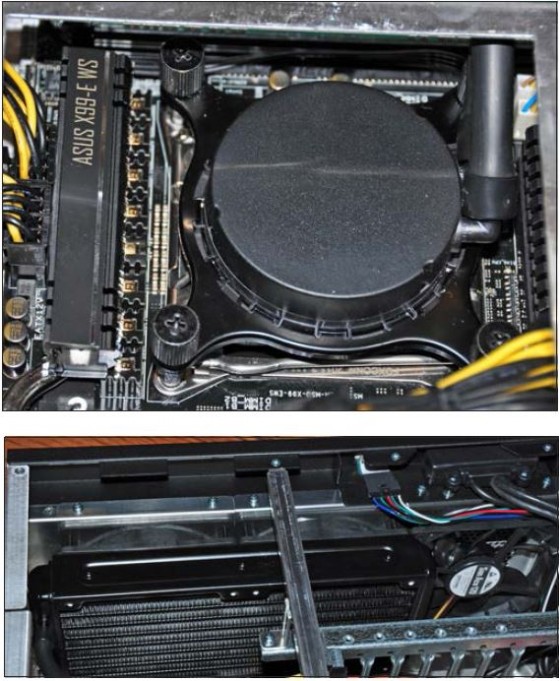
Over time, workstation vendors have dabbled with overclocking, in conjunction with liquid cooling to rein in thermal extremes that could cripple components. HP’s done it, along with a handful of smaller suppliers, but there’s no question who the leader in overclocked, liquid-cooled workstations is … it’s Boxx.
The Apexx 4 is the third workstation we’ve reviewed with a liquid-cooled CPU, and all were from Boxx. The water block on our Apexx 4’s Core i7 looks identical to the one that sat on our 4150 XT’s Core i7, and it’s not just there for show. It allows our CPU—one Intel specs to be clocked at a nominal 3.0 GHz—to be cranked up to 4.3 GHz. And despite the industry’s overarching trend to push more cores at the same frequency to increase maximum theoretical performance, the honest truth is that some workloads remain serial in nature, and performance for serial code benefits from the fastest frequencies.
Liquid cooling a CPU isn’t that different than liquid cooling a car engine. Coolant circulates from the source of the heat—in this case the CPU’s water block that sits in place of a traditional heat sink—to a radiator on the system’s front grill. Two fans drive fresh air through the radiator to cool the liquid before it heads back to the CPU’s water block. We assume fan speeds are dynamically adjusted, based on measured workload and/or internal temperatures.
As past reviews of Boxx workstations illustrated, the company has a knack for populating more storage bays than the competition. Eight or ten bays might seem like overkill to many, but in the high-end media space where many Boxx machines are sold, projects can easily chew up 10’s of terabytes, and more when paired with RAID configurations for reliability and/or performance.
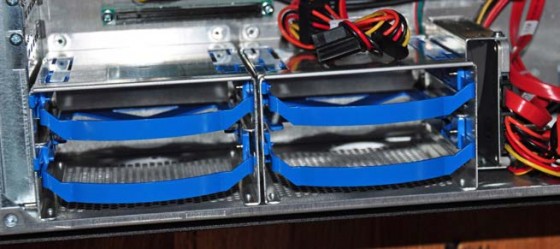
The reduced dimensions of a mini-tower chassis demands compromises, however, and there’s simply not room for eight bays inside. Instead, we find a more typical four 3.5-inch drive bays with one of the few tool-less designs: blue pull handles to retrieve drives. Next door are two 2.5-inch drive bays, one occupied by our Intel SSD.
Plenty of add-in slots and I/O
When it comes to expansion and connectivity, the Apexx 4 is not likely to disappoint. Its Asus X99-E motherboard can support seven—yes, seven— PCIe x16 connectors. Of those seven, Boxx allows population of up to four add-in GPU cards, topping the capabilities of many comparable mini-towers. However, constraints in available power (and quite possibly thermal dissipation) limit population to two high-end GPUs (supporting Nvidia SLI and AMD CrossFire dual-GPU configurations).
I/O options are more plentiful than lower end workstations, thanks to the premium Asus X99-E motherboard. The front matches the standard we’re finding on most workstations: two USB 2.0, two of the now more common USB 3.0 (blue), and mic in and audio out. But in the rear we find a bit more. There’s the expected Ethernet, audio, and additional USB ports, but the Apexx 4 outdoes most of its peers with 10 USB 3.0 ports and dual GigE interfaces. Common on higher end machines, the Apexx 4’s backside sports optical S/PDIF output and two eSATA ports for external storage expansion.
One of the USB 3.0 ports in back supports USB BIOS Flashback. In case you’re not familiar, the name says it all. Supported on Asus motherboards, Flashback allows an easy external update of the BIOS. Simply plug in the flash drive with new firmware in the root directory and hit the paired button. A light will flash as the update is in process, turning off to signal the flashback is complete.
Better suited to a PCI Express drive
Investing in top-end CPU and GPU performance, as well as big and fast memory, can get short-changed if frequently bottlenecked by slow I/O, for example, when reading and writing big model files. Today, an SSD not only makes an attractive upgrade in a modern workstation, we’d argue at this point—with capacities up and prices down—it should be a default upgrade for most. However, while the choice to choose an SSD is a clear one, the choice of where that SSD should reside is less obvious.
The vast majority of SSDs shipped to date have come installed in computers’ SATA drive bays, the same bays designed for HDDs and connected to the motherboard via a serial cable whose signaling and data rates are governed by the Serial ATA (SATA) standard. Our Apexx 4’s 240-GB SSD from Intel sat in a conventional drive bay with a SATA interface.
But there’s a relatively new choice available now as well: PCI Express SSDs. Where today’s SATA interface maxes out at 600 MB/second (peak rate), a two-lane PCI Express interface can provide around 2 GB/second, leaving more headroom to take advantage of the SSD’s inherent performance advantages. In addition, a new software interface (NVMe) has become available to unleash throughput closer to the SSD’s native rates. Boxx notified us that, while a PCI Express SSD was not available at the time our machine was configured (due to limited supply of the devices, they are now).
Benchmarking the Boxx Apexx 4
Whenever we benchmark a GPU or workstation, we look for hardware we’ve recently reviewed to make a meaningful comparison. In this case, the machine to compare the Apexx 4 to was obvious: the similar Boxx 4150X we’d benchmarked a year prior. As mentioned, the specs are remarkably similar, with the following exceptions:
- The Apexx 4’s CPU is a tad slower, but offers twice the processing cores.
- The Apexx 4’s Quadro K5200 is a comparably priced GPU, but newer and higher performing, than its predecessor in the 4150XT, the Quadro K5000.
- The Apexx 4 has twice the memory of the 4150XT, providing modestly higher bandwidth as well.
We tested both machines with the SPEC.org’s SPECwpc benchmark suite. SPECwpc’s whole-system testing gives a clearer idea of how the fully configured system will perform, considering the entire workload, including application, graphics, memory, OS, I/O, etc. It’s designed to be comprehensive, comprising separate suites, one per each of six verticals, including Media and Entertainment, Product Development, Energy, Life Sciences, Financial Services, and General Operations. Each suite includes anywhere from five to nine workloads, relevant to those specific spaces.
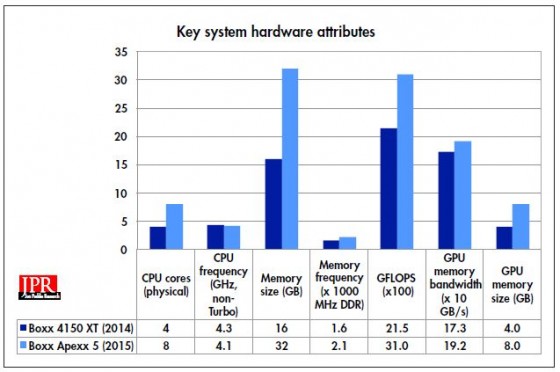
The benchmark reports a composite score, aggregating sub-test results, for each of the six application suites. We also include a price/performance comparison, reflecting SPECwpc scores per dollar (using sales price, as configured).
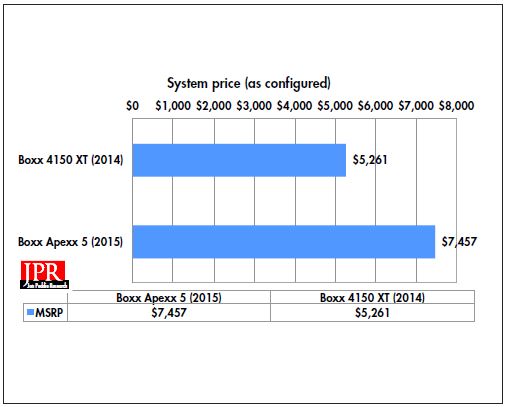
Boxx did its job. It created a machine that is substantially higher performance than its previous liquid-cooled, overclocked, single-socket beast from 2014, the 4150XT. The Apexx 4 posted composite scores anywhere from 91% better (Financial Services) to 18% (General Operations), with the varying degrees easily traced back to the machines’ relative strengths.
Product Development, Media and Entertainment, Life Sciences, and Energy all include subtests from Viewperf that stress the GPU, and the Quadro K5200 has a proven and significant edge over its predecessor, the K5000. All four also appear to reward both higher frequency clocking (for single-thread processing) and multiple cores (for multi-thread processing). The former benefits the older 4150XT, but the latter benefits the Apexx 4.

Financial Services, on the other hand, does not exhibit scores heavily dependent on the GPU, but does reward the Apexx 4’s 2X core count. And General Operations does not overly stress the GPU, while balancing single-thread and multi-thread processing, so it’s sensible that the Apexx 4 would achieve its narrowest margin for that suite.
The separation between our 4150XT and Apexx 4 is not only a year in time but over $2,000 in cost. Looking instead at SPECwpc price-performance (composite scores per dollar), Boxx still did an admirable job designing the Apexx 4 to squeeze more performance per dollar. Given its higher price, the Apexx 4’s edge over the 4150 XT is diminished, but it retained an edge in all but the General Operations suite (again sensible, given that suite’s characteristics).
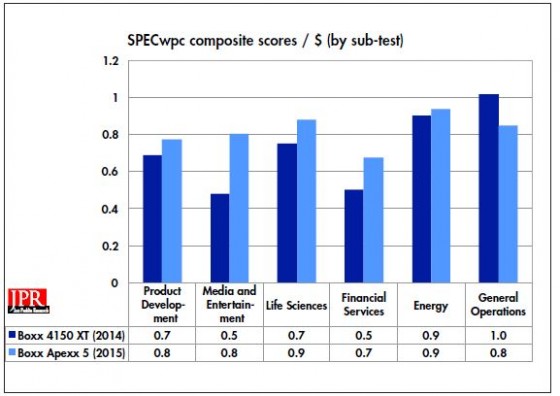
We won’t deluge the reader with all the raw performance and price/performance charts for each set of application-specific tests, but we include one for illustration: scores for the Product Development suite. Not only does Product Development represent the largest application space in workstation computing, its results illustrate the value of where dollars were spent in the two models’ different configurations. The Product Development suite shows a wide range of workloads with a wide range of performance results. Not surprising, the Apexx 4’s biggest edge comes in rendering the Viewperf viewsets (catia-04, showcase-01, snx-02 and sw-03), where the newer, faster Quadro K5200 shines. I/O performance is identical, also as expected since the two systems share the same SATA SSD. Finally, the Rodinia workload clearly takes advantage of the extra Apexx 4 CPU cores, while the Calculix doesn’t.
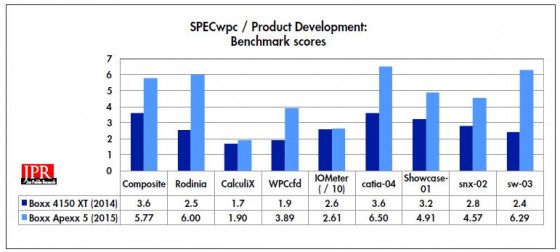
What do we think?
Boxx designs a workstation differently than its high-volume Tier 1 peers, and intentionally so. Boxx isn’t going to win business with me-too features, so it doesn’t—and shouldn’t—feel compelled to match exactly what HP, Dell and Lenovo do. Passing on some of the ergonomic features like chassis handles and comprehensive tool-less access reflects that position. Boxx instead chooses to differentiate in areas like superior performance and robustness.
We don’t think most end-users will mind or even care about the lack of tool-less access. In fact, what you’re getting in return is the feeling of very solid construction and retention. Boxx machines always feel bulletproof.
We’re not crazy about it, however. We’re constantly moving, opening and swapping out components on our reviews, much more than the average user. And admittedly, we might have gotten spoiled with both the outside handle and the generally simply, no tools-required access to virtually everything inside. Now, a single end-user may rarely move the machine, and quite possibly may never find the need to get at internal components. So no, an individual user may not care about tool-less, or certainly wouldn’t care in light of all the other benefits Boxx delivers. But we do wonder if IT personnel configuring 10’s or 100’s might care.
And tools or no tools, there was the separate problem of releasing the K5200. Granted, with a GPU of that caliber, the likelihood of having to remove it over the life of the machine is probably slim. Still, there needs to be design that allows a card to be removed with reasonable effort.
When it comes to performance, however, there is no debate at all. With the combination of the overclocked CPU, that lets it excel at single-thread code, and the eight physical cores (double that of most lower-end workstations), that efficiently churns through multi-thread processing, the Apexx 4 offers excellent, balanced, top-end performance. In fact, the Apexx 4 posted the highest scores we’ve seen to date, besting even the near $9K, dual-CPU Lenovo P900 we recently reviewed. With more memory, more cores and a faster GPU, the configuration also provides a nice bump over a comparable single-socket, overclocked machine from the year prior, even when taking into account its higher price.
The only area we could find Boxx missed on performance for this particular configuration was in the SSD. A SATA SSD might be OK for a lower-end model, but for something of the caliber of this Apexx 4 configuration, a PCI Express SSD would be a better match. However, while a PCIe SSD was not available at the time our machine was built, Boxx assures us they are now.
Alex Herrera is a senior analyst for Jon Peddie Research.





